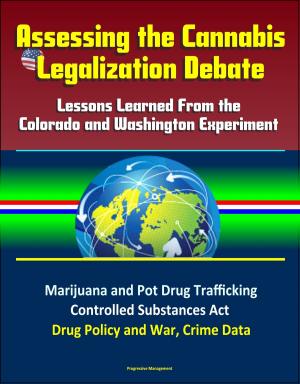2014 Complete Guide to the TransCanada Keystone XL Pipeline: State Department Final Supplemental EIS, Risks to the Environment and Water Resources, Congressional Report
Nonfiction, Science & Nature, Science, Biological Sciences, Ecology, Social & Cultural Studies, Political Science, Government, Public Policy| Author: | Progressive Management | ISBN: | 9781310781001 |
| Publisher: | Progressive Management | Publication: | February 1, 2014 |
| Imprint: | Smashwords Edition | Language: | English |
| Author: | Progressive Management |
| ISBN: | 9781310781001 |
| Publisher: | Progressive Management |
| Publication: | February 1, 2014 |
| Imprint: | Smashwords Edition |
| Language: | English |
Gain a complete understanding of the important controversy about the Keystone XL pipeline project with this flowing-text e-book containing a collection of official documents - including the State Department Final Supplemental Environmental Impact Statement (EIS) executive summary released in January 2014 - on the risks of the pipeline. The compilation also includes the December 2013 Congressional Research Report, Keystone XL Pipeline Project Key Issues.
TransCanada Keystone Pipeline, LP (Keystone) filed an application in 2008 for a Presidential Permit with the Department of State to build and operate the Keystone XL Project. The proposed Keystone XL Project consists of a 1,700-mile crude oil pipeline and related facilities that would primarily be used to transport Western Canadian Sedimentary Basin crude oil from an oil supply hub in Alberta, Canada to delivery points in Oklahoma and Texas. The proposed Project would also be capable of transporting U.S. crude oil to those delivery points. The proposed project could transport up to 830,000 barrels per day and is estimated to cost $7 billion. As part of the Presidential Permit review process, the Department has prepared an Environmental Impact Statement (EIS) consistent with the National Environment Policy Act (NEPA). The issuance of a Final EIS is one step in the review process and does not represent a final decision on the permit application.
The proposed Keystone XL pipeline would consist of approximately 1,711 miles of new 36-inch-diameter pipeline, with approximately 327 miles of pipeline in Canada and 1,384 miles in the U.S. The proposed Project would connect to the northern and southern ends of the existing Cushing Extension of the Keystone Oil Pipeline System.
The proposed Keystone XL Project would primarily transport crude oil extracted from the oil sands areas in Alberta, Canada. Oil sands (which are also referred to as tar sands) are a combination of clay, sand, water, and bitumen, which is a material similar to soft asphalt. Bitumen is extracted from the ground by mining or by injecting steam underground to heat the bitumen to a point where it liquefies and can be pumped to the surface. Bitumen is treated in several ways to create crude oil suitable for transport by pipeline and refining. The types of Canadian crude oil that would be transported by the proposed Project would primarily consist of synthetic crude oil and diluted bitumen. Synthetic crude oil is produced from bitumen using refining methods - a process termed upgrading - that in general converts bitumen into lighter liquid hydrocarbons. In other words, the bitumen is converted into a crude oil similar to conventional crude oil.
Gain a complete understanding of the important controversy about the Keystone XL pipeline project with this flowing-text e-book containing a collection of official documents - including the State Department Final Supplemental Environmental Impact Statement (EIS) executive summary released in January 2014 - on the risks of the pipeline. The compilation also includes the December 2013 Congressional Research Report, Keystone XL Pipeline Project Key Issues.
TransCanada Keystone Pipeline, LP (Keystone) filed an application in 2008 for a Presidential Permit with the Department of State to build and operate the Keystone XL Project. The proposed Keystone XL Project consists of a 1,700-mile crude oil pipeline and related facilities that would primarily be used to transport Western Canadian Sedimentary Basin crude oil from an oil supply hub in Alberta, Canada to delivery points in Oklahoma and Texas. The proposed Project would also be capable of transporting U.S. crude oil to those delivery points. The proposed project could transport up to 830,000 barrels per day and is estimated to cost $7 billion. As part of the Presidential Permit review process, the Department has prepared an Environmental Impact Statement (EIS) consistent with the National Environment Policy Act (NEPA). The issuance of a Final EIS is one step in the review process and does not represent a final decision on the permit application.
The proposed Keystone XL pipeline would consist of approximately 1,711 miles of new 36-inch-diameter pipeline, with approximately 327 miles of pipeline in Canada and 1,384 miles in the U.S. The proposed Project would connect to the northern and southern ends of the existing Cushing Extension of the Keystone Oil Pipeline System.
The proposed Keystone XL Project would primarily transport crude oil extracted from the oil sands areas in Alberta, Canada. Oil sands (which are also referred to as tar sands) are a combination of clay, sand, water, and bitumen, which is a material similar to soft asphalt. Bitumen is extracted from the ground by mining or by injecting steam underground to heat the bitumen to a point where it liquefies and can be pumped to the surface. Bitumen is treated in several ways to create crude oil suitable for transport by pipeline and refining. The types of Canadian crude oil that would be transported by the proposed Project would primarily consist of synthetic crude oil and diluted bitumen. Synthetic crude oil is produced from bitumen using refining methods - a process termed upgrading - that in general converts bitumen into lighter liquid hydrocarbons. In other words, the bitumen is converted into a crude oil similar to conventional crude oil.















